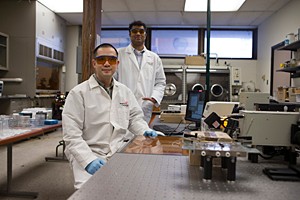
UC Researchers Report on Discovery to Make Solar Power Less Expensive and More Efficient
University of Cincinnati researchers are reporting early results on a way to make solar-powered panels in lights, calculators and roofs lighter, less expensive, more flexible (therefore less breakable) and more efficient.
Fei Yu, a University of Cincinnati doctoral student in materials engineering, will present new findings on boosting the power conversion efficiency of polymer solar cells on March 3, at the American Physical Society Meeting in Denver.
Yu is experimenting with adding a small fraction of graphene nanoflakes to polymer-blend bulk-heterojunction (BHJ) solar cells to improve performance and lower costs of solar energy.
There has been a lot of study on how to make plastic solar cells more efficient, so they can take the place of silicon solar cells in the future, says Yu. They can be made into thinner, lighter and more flexible panels. However, theyre currently not as efficient as silicon solar cells, so were examining how to increase that efficiency.
Imagine accidentally kicking over a silicon solar-powered garden light, only to see the solar-powered cell crack. Polymers are carbon-based materials that are more flexible than the traditional, fragile silicon solar cells. Charge transport, though, has been a limiting factor for polymer solar cell performance.

Fei Yu (
Graphene, a natural form of carbon, is a relatively newly discovered material thats less than a nanometer thin. Because graphene is pure carbon, its charge conductivity is very high, explains Yu. We want to maximize the energy being absorbed by the solar cell, so we are increasing the ratio of the donor to acceptor and were using a very low fraction of graphene to achieve that.
Yus research found that efficiency increased threefold by adding graphene, because the material was helping to rapidly transport charges to achieve higher photocurrent. The increased performance, although well below the highest efficiency achieved in organic photovoltaic (OPV) devices, is nevertheless significant in indicating that pristine graphene can be used as a charge transporter, says Yu.
Yus advisor, Vikram K. Kuppa, an assistant professor in the School of Energy, Environmental, Biological and Medical Engineering (SEEBME) for the UC College of Engineering and Applied Sciences (CEAS), was a contributor to the research. Kuppa is leading the research of a variety of polymer-blend solar cells involving the use of graphene.
Future research will focus on device physics, film morphology and how to control and optimize these randomly distributed graphene nanoflakes by a variety of methods to achieve better performance.
The
meeting is the largest meeting of its kind in the world, and focuses on research from industry, universities and major labs. The meeting brings together nearly 10,000 physicists and students to share their groundbreaking research.
UCs College of Engineering and Applied Science
is a leader in engineering education, research and innovation, and is the world founder of cooperative education.
Related Stories
OTR mural celebrates UC alumni success
April 4, 2025
The UC Alumni Association, UCAA, will mark its annual Alumni Celebration during its upcoming Alumni Week, April 7-13, with a community art project commemorating this year’s slate of alumni honorees receiving the organization’s top awards.
UC students combine engineering and design experience
April 3, 2025
At the University of Cincinnati, the College of Design, Art, Architecture and Planning hosted a design competition with HAAG-Streit USA, where students were tasked with designing an ophthalmology workstation that is accessible and able to be incorporated into retail settings. Caleb Loayza, a mechanical engineering student at the College of Engineering and Applied Science, and Guy Mueller, an industrial design student, combined their expertise and took home first place.
Grad school requirements: What you need to apply and get accepted
Applying to grad school? Learn about key admission requirements, including GPA, test scores, letters of recommendation, and deadlines, to submit a strong application with confidence. Get expert tips and a checklist to stay on track.
